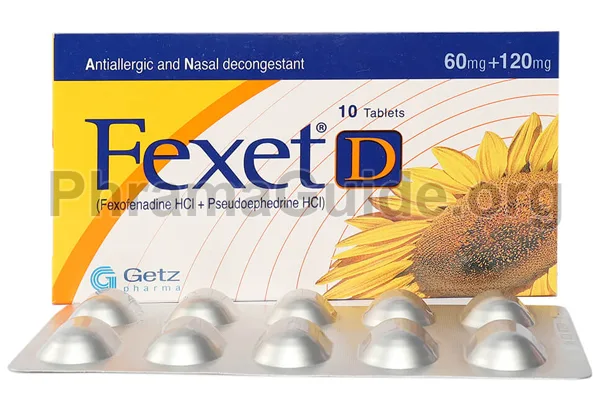Fexet D is primarily used to provide relief from symptoms associated with allergies and nasal congestion due to allergic rhinitis or the common cold. Following are some common uses of the Fexet D tablet:
- Allergic Rhinitis (Hay Fever): Fexet D tablet is used to relieve symptoms such as sneezing, runny or stuffy nose, itching, and watery eyes that are often associated with allergic rhinitis or hay fever. Fexet D helps to block the effects of histamine, a substance produced by the body in response to allergens.
- Nasal Congestion: Fexet D tablet is also used to relieve congestion in the nasal passage. It helps reduce swelling and congestion in the nasal passages, making it easier to breathe.
- Sinus Congestion and Pressure: Fexet D tablet is often used to address symptoms associated with sinus congestion and pressure, which can be caused by allergies or upper respiratory infections.
- Common Cold: Fexet D tablets may be used to alleviate symptoms of the common cold, including nasal congestion, runny nose, and sneezing.
- Seasonal Allergies: Fexet D tablets may be used to manage symptoms caused by seasonal allergies, especially when both congestion and allergic reactions are present.
Off-label Uses of Fexet D Tablet
- Sinusitis: Some healthcare providers may consider prescribing Fexet D as part of a treatment regimen for sinusitis, a condition characterized by inflammation of the sinuses often due to infection.
- Otitis Media (Middle Ear Infection): In some cases, healthcare providers may recommend Fexet D as part of the treatment plan for middle ear infections, particularly if nasal congestion is a significant symptom.
- Eustachian Tube Dysfunction: Eustachian tube dysfunction can cause ear pressure, pain, and hearing difficulties. Fexet D may be considered to help alleviate congestion and associated symptoms.
- Chronic Rhinosinusitis: Fexet D might be included in a treatment plan for chronic rhinosinusitis, a condition characterized by persistent inflammation of the sinuses.
- Vasomotor Rhinitis: This is a non-allergic form of rhinitis that can cause nasal congestion and other symptoms. Fexet D may be used off-label in some cases to manage symptoms.
- Postnasal Drip: Fexet D may be considered for individuals experiencing postnasal drip, a condition where excess mucus accumulates in the back of the throat and can lead to coughing or a sore throat.
- Acute Upper Respiratory Tract Infections: Fexet D may be used in conjunction with other treatments to help relieve symptoms associated with upper respiratory tract infections, such as the common cold.

What is Fexet D?
Fexet D is one of the leading brands of Fexofenadine and Pseudoephedrine, manufactured and marketed by Getz Pharmaceuticals, Pakistan.
Fexet D : Available Formulations and Strengths
Presently, Fexet D is available in Tablets Form.
Fexet D Tablet : Fexofenadine 60mg, and Pseudoephedrine 120mg strength.
Fexet Tablets : 60mg, 120mg, and 180mg Strengths.
Who Should Not Use Fexet D?
There are some conditions that may contraindicate the use of either Fexet D tablet.
People suffering from kidney disease.
People suffering from high blood pressure.
People suffering from heart disease.
People suffering from diabetes.
People suffering from glaucoma
People suffering from a thyroid disorder.
People suffering from liver disease.
People suffering from an enlarged prostate.
People suffering from urinary obstruction.
Pregnant women and nursing mothers should not use Fexet D without consultation with a healthcare professional.
In addition, patients taking certain other medications such as anticoagulants (blood thinners), monoamine oxidase inhibitors (MAOIs), and muscle relaxants may experience dangerous interactions when using either drug. So it’s important to discuss all medical history with your doctor before starting Fexet D.
What is the Recommended Daily Dosage of Fexet D?
Dosage for Adults and Children 12 years of age and Older:
Usual Fexet D is recommended as One tablet two times a day and taken with water before a meal.
How Fexet D Works?
Fexofenadine is an antihistamine drug and works by inhibiting histamine, a chemical substance responsible for allergy symptoms in the body.
Pseudoephedrine is a decongestant drug and works by activating α- and β-adrenergic receptors directly, and it’s drying up the nasal passages.
Thus, the Fexet D tablet works to relieve allergies and congestion.
Related Links:

Leave A Comment